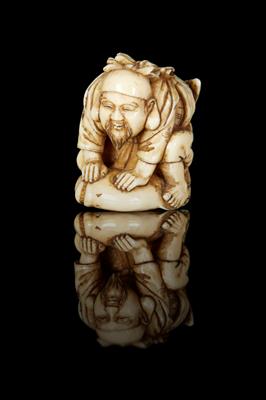Netsuke
Download media
Object number07188
TitleNetsuke
DescriptionThis gorgeously carved sculpture was made in Japan in the 19th century. Called a netsuke, it is so compact that it would easily fit into the palm of your hand. Despite their beauty, they are very practical objects, used from the late 16th century to the late 19th century.
The kimono, the traditional Japanese form of dress, had no pockets. While women would tuck small items into their sleeves, men would hang their essentials (tobacco pouches, seals, purses and so on) on a cord from their sash (obi). In a way, it is very similar to using a sporran! The netsuke was used as a toggle on the cord which stopped it from slipping back through the sash.
This netsuke is made from ivory and takes the form of Ebisu, one of the Seven Gods of Luck, pinning down a large Tai fish. Regarded as the God of Fishermen and of plentiful food, Ebisu is also the God of honest dealing.
While ivory was often used, netsuke can also be made from hardwood, metal, porcelain – even carved from nuts and coral. They often took the form of real or mythological animals. Some were figures from folklore, history or theatrical masks. At a time when everyone knew their place in society, the tiny netsuke could be worn as a symbol of individuality, small enough not to draw unwanted attention.
The opening up of Japan to foreign trade in 1854 led to Western influence on clothing; suits and uniforms replaced the kimono in everyday life. Demand for netsuke as an accessory declined but their place as an art form was assured, and they remain extremely collectible to this day.
Production placeJapan,
Object nameNetsuke
MaterialIvory
TechniqueCarved
Dimensions
whole Height: 38 mm
whole Width: 30 mm
whole Width: 30 mm




